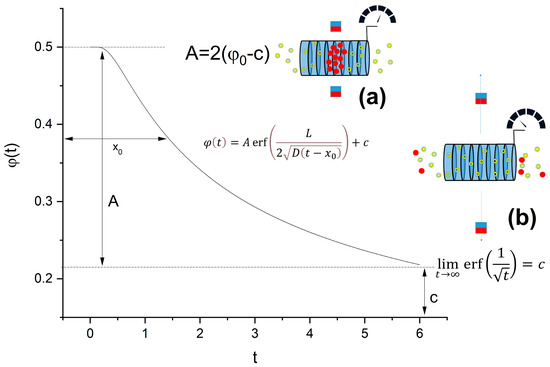Abstract
A novel methodology for the sizing of magnetic nanoparticles (MNPs) based on diffusion is described herein. The sensing core is an electrical coil wrapped around a capillary filled by an MNP solution. We show that it is possible to determine MNPs’ hydrodynamic radius by employing off-the-shelf electronic equipment by measuring the decrease in coil inductance when MNPs diffuse out of the coil by Brownian motion.
1. Introduction
The early detection of molecular biomarkers (BMs) allows for targeted therapies of various diseases, substantially reducing the doses required for pharmacological therapy and surgical invasiveness. Protein BMs are widely recognized as key indicators for important orthopedic disorders [1], cancer [2], neurodegenerative diseases [3], and others. Even though their discovery has been an impressive advancement for science, the development of clinical diagnostic tools based on BMs remains, as of yet, an actively pursued goal by both academia and industry. Herein, we describe a novel concept for an ultrasensitive bio-diagnostic based on the different diffusivity of magnetic nanoparticles (MNPs) with and without the examined BM. The diffusivity of MNPs can be suitably and accurately measured with various magnetic sensors due to the presence of the magnetic moment of the nanoparticles. Magnetic detection can be operated across a vast range of BM concentrations, starting from ultra-low femtogram quantities to nano-, micro-, and milligrams, by employing different types of sensors. Herein, we address the concentrations in the range of a few mg/ml and demonstrate that the simple inductive coil-based detection of magnetic species allows one to define the diameters of the MNPs with accuracies close to a few nanometers.
2. Materials and Methods
The sensing core is an electrical coil wrapped around a capillary where a batch of MNPs are initially magnetically confined. Upon releasing the confining magnet, the MNPs are free to diffuse out of the coil as sketched in Figure 1. By measuring the associated decrease in the coil’s inductance, we can determine the diffusivity coefficient of the MNPs and hence their hydrodynamic radius by employing off-the-shelf electronic equipment. Herein, we experimentally show that our device can reliably measure the diameter of Fe3O4 MNPs with three different sizes: 70, 30, and 20 nm (as measured via TEM).

Figure 1.
Concept of the sensor. At the beginning of the experiment (a), MNPs are magnetically confined in the coil and it has a high inductance. When the MNPs are free to diffuse, they leave the coil and its inductance decreases (b). The decrease in inductance follows the equation shown in the picture. In the plot, inductance (y-axis) and time (x-axis) are given in arbitrary units.
Moreover, the direct detection of a protein is demonstrated on the BSA-coated 20 nm large Fe3O4 MNPs as to mimic the presence of a clinically important BM. Our results indicate that this simple detection scheme, compatible with portable point-of-care devices, provides a detection accuracy by far exceeding the wide-spread dynamic light scattering technique.
We will also report on the very attractive option of magnetically enhancing by orders of magnitude the concentration of BMs in patient samples, thus providing the possibility to employ standard diagnostic techniques, such as ELISA, for concentrations well below their factual limits [4,5].
Author Contributions
A.S. performed the experiments and analyzed the experimental results, L.G. performed the experiments, T.S. conceptualized the experiments, M.A.G.-G., Y.P. and J.R. fabricated and characterized the MNPs. G.G. and V.A.D. were in charge of project administration and funding acquisition. A.S., L.G., T.S. and V.A.D. conceptualized the experiments and wrote the manuscript. All authors have read and agreed to the published version of the manuscript.
Funding
This research was funded by the European Union’s Horizon 2020 research and innovation programme under the project MADIA—MAgnetic DIagnostic Assay for Neurodegenerative Disease—grant agreement no. 732678, BOW—Biogenic Organotropic Wetsuits—grant agreement no. 952183, and from the Italian National Recovery and Reliance Plan (NRRP), part of the European Union’s NextGenerationEU programme, under the project ECOSISTER-ECOSystem for sustainable transition of Emilia-Romagna-ECS 00000033.
Data Availability Statement
The raw data supporting the conclusions of this article will be made available by the authors on request.
Acknowledgments
The authors thank Salvino Rose for his technical assistance. Alberto Riminucci deserves a distinct acknowledgment for his helpful discussions.
Conflicts of Interest
The authors declare no conflicts of interest.
References
- D’Oronzo, S.; Brown, J.; Coleman, R. The role of biomarkers in the management of bone-homing malignancies. J. Bone Oncol. 2017, 9, 1–9. [Google Scholar] [CrossRef] [PubMed]
- Sarhadi, V.K.; Armengol, G. Molecular Biomarkers in Cancer. Biomolecules 2022, 12, 1021. [Google Scholar]
- Hansson, O. Biomarkers for neurodegenerative diseases. Nat. Med. 2021, 27, 954–963. [Google Scholar] [CrossRef] [PubMed]
- Surpi, A.; Shelyakova, T.; Murgia, M.; Rivas, J.; Piñeiro, Y.; Greco, P.; Dediu, V.A. Versatile magnetic configuration for the control and manipulation of superparamagnetic nanoparticles. Sci. Rep. 2023, 13, 5301. [Google Scholar] [CrossRef] [PubMed]
- Surpi, A.; Murgia, M.; López, S.; González, M.; Piñeiro, Y.; Rivas, J.; Perugini, P.; Santin, M.; Sobrino, T.; Greco, G.; et al. Magnetic separation and concentration of Aβ 1-42 molecules dispersed at the threshold concentration for Alzheimer’s disease diagnosis in clinically-relevant volumes of sample. J. Nanobiotechnol. 2023, 21, 329. [Google Scholar] [CrossRef] [PubMed]
Disclaimer/Publisher’s Note: The statements, opinions and data contained in all publications are solely those of the individual author(s) and contributor(s) and not of MDPI and/or the editor(s). MDPI and/or the editor(s) disclaim responsibility for any injury to people or property resulting from any ideas, methods, instructions or products referred to in the content. |
© 2024 by the authors. Licensee MDPI, Basel, Switzerland. This article is an open access article distributed under the terms and conditions of the Creative Commons Attribution (CC BY) license (https://creativecommons.org/licenses/by/4.0/).